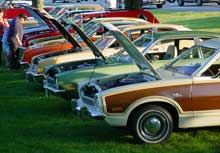It used to be the conventional wisdom that no one would ever collect cars from the 1970s. I have never believed this – every car will some day have its moment of collectability – but I once said I hoped I’d never see a Pinto at a car show. I ate crow for that statement a long time ago. Today there are Pinto clubs and Pinto posses, and Ford’s little subcompact has a culture all its own.
The Pinto came on the scene in 1971, following the Falcon-replacement Maverick and undercutting it in size and price. Once problems with fuel tanks and broken door handles were overcome, the Pinto proved a reliable and economical little car. Performance of the first cars, with 1,600 cc British-built “Kent” engine, was a bit underwhelming, but a 2-liter ohc unit from Ford of Germany was soon substituted. By 1974, Pintos were being propelled by a husky 2.3-liter ohc four built in Ohio, an engine so sturdy that it found its way into third-generation Mustangs and, with turbocharger, Thunderbirds and the German-built Merkur XR4Ti. A 2.8-liter V6 followed the next year.
Diane Mierz has always wanted a Pinto. Two years ago she found one, a low-mileage 1973 Squire wagon, with 2-liter engine and automatic transmission. She and her husband Steve took it to Hershey that autumn, and entered it in the car show. Steve, webmaster for the Shoreline Antique Auto Connection, soon set up the Connecticut Pinto Registry, an online news and information resource for Pinto partisans.
Three weeks ago Connie and Bill from Glastonbury, Connecticut, organized a Pinto stampede at the regular monthly cruise night on the green in Colchester, held by the Good Times Motoring Club. Seven Pintos came to celebrate the Summer solstice, including Connie’s own 1978 runabout, Bill’s 1977 sedan with T-Bird turbo engine, and Diane’s Squire wagon. Glenn and George from New London showed up with no less than four: a mint 1972 sedan that was my first car-show-Pinto sighting in Norwich a few years ago, a 1976 Squire runabout with factory V6, a Cruising Wagon and a ’77 sedan into which they have stuffed a 302 V8.
Pinto’s swan song was the 1980 model. Fred Summers, our St. Louis bureau chief, ordered a Cruising Wagon for his wife Sharon, without the wacky graphics package that was available. Cruising wagons had a special interior with tachometer and rally steering wheel. When the 1981 model year came around, the Pinto had been replaced by the front-wheel drive Escort, billed as a “world car” because the same model was made in Britain, Germany and several other countries. The Pinto had done well, with two million sold in ten years, and its reputation intact. Its competition, the rough and rusty Chevy Vega with an unlined aluminum engine, a type better suited to a lawn mower, must be green with envy.

